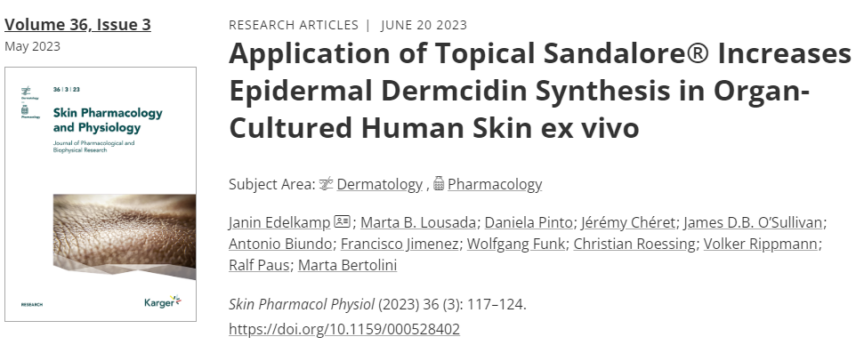Originally, olfactory receptors (ORs) were described to detect odors. Consequently, they are well known to play a central role for smelling in mammals. However, ORs are not only expressed in the nose, instead we, at Monasterium Laboratory, demonstrated that their physiological functions extends beyond that of olfaction, since these receptors are also functionally expressed in the skin, where they regulate skin pigmentation, wound healing, and hair growth.
The best-studied OR in the skin is the OR family 2 subfamily AT member 4 (OR2AT4), which is activated by Sandalore®, a synthetic sandalwood mimetic. We have previously demonstrated that Sandalore® treatment induces the transcription of antimicrobial peptides (AMPs), such as dermcidin (DCD) and cathelicidin (LL37), in the human hair follicle epithelium. These findings prompted us to investigate whether stimulation of OR2AT4 with Sandalore® may contribute to the regulation of the skin microbiota. Of note, microbial dysbiosis is greatly implicated in skin disorders such as atopic dermatitis and psoriasis. Therefore, microbiome regulation presents an interesting target to develop effective treatment strategies.
In a recently published a manuscript by our CSO Dr. Janin Edelkamp in the scientific journal Skin Pharmacology and Physiology, we tried to shed light on the interplay between OR2AT4, Sandalore® and the human skin microbiome. Therefore, we used our full-thickness human skin organ culture assay and topically applied Sandalore® (to mimick its application via cremes or sera onto the skin). Sandalore® increased the epidermal production of AMPs, including DCD, and induced expression of OR2AT4, suggesting a positive feedback mechanism that could result into an amplified production of AMPs over time. In a next step, we were interested whether the secreted AMPs would indeed affect microbial growth. Therefore, the conditioned, organ-culture media were collected and applied to bacterial cultures of S. epidermidis, S. aureus, C. acnes, M. restricta, and M. globose, all of which are important for regulating skin physiology and barrier function. Interestingly, viability of S. aureus was reduced by Sandalore® treatment, while viability of S. epidermidis, M. restricta and C. acnes were increased, in line with a more balanced and benefitial microbiome.
Our results show for the first time that OR modulation differentially affects AMP production and microbiome composition in the skin. These findings pave the way to modulate ORs to selectively regulate viability and growth of key bacterial species for the management of skin disorders characterized by microbial dysbiosis such as atopic or seborrheic dermatitis using Sandalore® as an attractive, adjuvant treatment option to classical antibiotics.
Read the full story here: Application of topical Sandalore® increases epidermal dermcidin synthesis in organ-cultured human skin ex vivo – PubMed (nih.gov)


